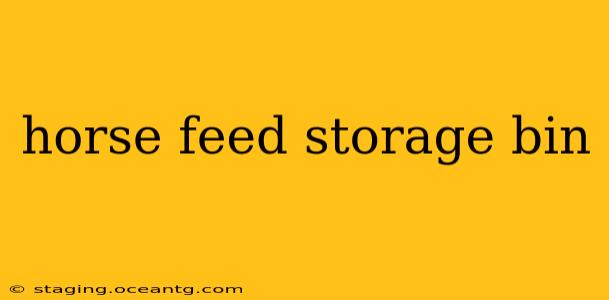Keeping your horse healthy and happy relies heavily on proper nutrition, and a crucial part of that is storing their feed correctly. A good horse feed storage bin protects your investment, prevents spoilage, and safeguards your horse's health. This comprehensive guide explores the various types of horse feed storage bins, their pros and cons, and how to choose the best one for your needs.
What are the Different Types of Horse Feed Storage Bins?
The market offers a variety of horse feed storage bins, each with its own set of features and benefits. Let's explore some of the most popular options:
-
Metal Bins: These are often made of galvanized steel or other durable metals. They're robust, weather-resistant, and offer excellent protection against pests. However, they can be more expensive than other options and may rust over time if not properly maintained.
-
Plastic Bins: Plastic bins are lightweight, relatively inexpensive, and come in a wide range of sizes. They're easy to clean and move, but they're not as durable as metal bins and can be prone to cracking or breaking under extreme conditions.
-
Wooden Bins: Wooden bins offer a rustic aesthetic and can be built to custom sizes. They're often well-insulated, protecting feed from extreme temperatures. However, wood requires regular maintenance to prevent rot and infestation by pests. Proper sealing and treatment are crucial.
-
Outdoor Feeders with Storage: Some outdoor feeders incorporate storage compartments, combining feeding and storage in one unit. This can be a convenient option, but the storage capacity might be limited.
How Much Horse Feed Storage Do I Need?
The size of the storage bin you need depends on several factors, including:
- Number of horses: More horses require more feed.
- Type of feed: Hay takes up significantly more space than grain.
- Feeding frequency: How often do you feed your horses?
- Storage duration: Do you buy feed in bulk?
It's advisable to overestimate your needs slightly to allow for fluctuations in feed consumption and potential delays in replenishing supplies.
What are the Benefits of Using a Horse Feed Storage Bin?
Investing in a quality horse feed storage bin offers several key advantages:
- Protection from the elements: Shields feed from moisture, sun, and extreme temperatures, preserving its quality and nutritional value.
- Pest control: Prevents rodents, insects, and birds from accessing and contaminating the feed.
- Organization and convenience: Keeps feed clean, dry, and easily accessible.
- Reduced waste: Prevents spoilage, ensuring you get the most out of your feed investment.
- Improved safety: Reduces the risk of horses injuring themselves while trying to access unsecured feed.
What Materials Are Best for Horse Feed Storage?
The best material for your horse feed storage bin depends on your specific needs and budget. However, galvanized steel is often considered the most durable and pest-resistant option, making it a popular choice for many horse owners. Plastic bins are a good budget-friendly alternative, provided they are UV-stabilized to withstand sun exposure.
How Do I Keep My Horse Feed Storage Bin Clean?
Regular cleaning is crucial to maintaining the quality and safety of your horse's feed. Empty the bin completely at least once a month, and scrub it thoroughly with a stiff brush and warm, soapy water. Rinse well and allow it to dry completely before refilling. Consider using a mild disinfectant to further sanitize the bin.
What Size Horse Feed Storage Bin Should I Buy?
There’s no single answer to this. The ideal size will vary based on your individual circumstances. Consider factors mentioned earlier: number of horses, feed type, frequency of feeding, etc. Start by calculating your average monthly feed consumption and choose a bin that provides ample storage capacity while also considering the available space in your stable or barn.
How Do I Prevent Pests from Getting Into My Horse Feed Storage Bin?
Pest control is a critical aspect of proper feed storage. Consider these preventative measures:
- Airtight seals: Ensure your bin has a tight-fitting lid to prevent entry.
- Regular cleaning: Thorough and frequent cleaning eliminates attractants and breeding grounds.
- Placement: Store bins in a cool, dry, well-ventilated area. Avoid damp or humid environments.
- Pest control measures: Use commercially available rodent and insect repellents if necessary, following product instructions carefully. Keep the surrounding area clean and free of debris.
By carefully considering these factors and choosing the right horse feed storage bin, you can ensure your equine companion receives the nutritious, high-quality feed they deserve. Remember, a small investment in a good storage bin can significantly impact your horse’s overall health and well-being.
